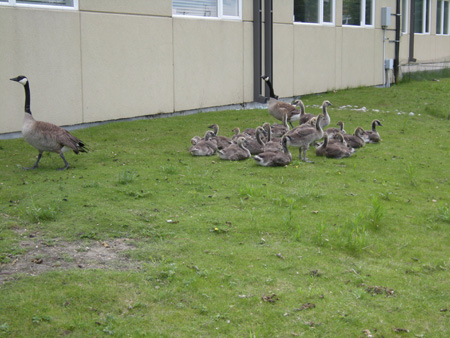Holiday season – View holiday hours for City of Winnipeg facilities and services from December 24 to January 1.

Feeding Geese
Feeding of geese is an activity that many in the City enjoy. Feeding of geese although enjoyable for some individuals is generally discouraged. There are a few reasons for this:
Changes the behaviour of geese

Geese that are fed will begin to approach humans without fear and some may begin to approach humans in a more aggressive manner. We should remember that not all park users are bigger than geese, kids use parks, too.
In parks where feeding by humans is the norm, there is a notable difference in goose behaviour. It is very easy to tell which geese are being fed, just stand around long enough and you will soon have many feathered companions.
It is important to remember our geese in Winnipeg still migrate and spend the winter in the United States where they may be subject to population control, including lethal control. Losing their wariness of humans may put the geese at greater risk in their wintering grounds.
When food is thrown on land, Canada Geese will begin to leave the water when they see people - this could put them at risk from urban predators, such as dogs and fox.
Just over the border in the US, geese are year-round residents. As long as there is available food and open water, geese may stay around and delay their migration.
The food being provided may not fit the nutritional requirements of the geese
Slipped wing or angel wing is often noted as a reason for advocating against feeding Canada Geese. This condition occurs when one of the joints on a bird's wing is twisted which causes the feathers on the wing to extend out from the body rather than lying flat when at rest. Some reports say genetics is the cause for this condition while others indicate it is from being given food that is not nutritionally appropriate.
If it is not considered healthy for humans, it is not healthy for geese. Unfortunately, geese seem to be fed bread, chips, cake, cookies and cereal, and other processed foods. Geese are herbivores and thrive on plant material. It is important to remember that urban geese already have enough food, in the form of vast mown lawns, to keep them healthy.
Reduces the effectiveness of deterrents measures
The use of deterrents can be part of the solution for keeping geese away from sensitive areas. Achieving success using deterrent tactics is already difficult due to habituation (i.e. the geese get used to the scare after a while) and feeding may reduce the success of deterrent techniques even further.
Other considerations
From an animal welfare perspective, large numbers of geese feeding in a small area can make geese more susceptible to contracting avian diseases.
Geese congregating in areas where food is being provided concentrates their waste into a smaller area. When goose droppings are concentrated and not spread out, the pressure to control geese can rise.
As an animal lover, feeding a connection to wildlife may be important. However, it is important to remember that there are individuals that will harm animals. It is best to keep geese wary of humans and try not to turn them into a pet by feeding them.
